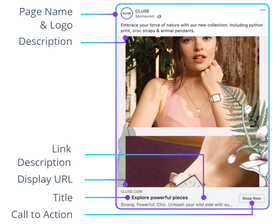Social Media Ads Cost Breakdown: Facebook, Instagram, TikTok, Pinterest and More
Get a full comparison of how much it costs to advertise on popular social media platforms including Facebook, Instagram, TikTok, Pinterest, and more.
Read More
For years, Facebook has been a critical channel in the digital marketing world, used by large and small businesses. With over one billion people on the platform, Facebook represents an enormous marketing opportunity for brands that know how to take advantage of Facebook's tools.
Of course, Facebook's massive size and reach also mean that it's a highly competitive advertising environment, and advertising your small business on Facebook can come with challenges. It can be challenging to ensure you're targeting the right ones for your business with so many users. Likewise, with virtually every brand on the planet marketing on Facebook as well, there's plenty of competition for users' feeds, attention, and their dollars.
That said, Facebook remains a valuable marketing channel for most brands. In this article, we'll explain why you should be using Facebook for marketing your small business, cover the basic ad types available to advertisers, and go over basic steps and best practices to get you started.
There are three major types of Facebook ads. Each contains some subtypes with varying parameters so that you can post your ads in a range of formats and keep your campaigns feeling fresh and new to shoppers.
The most basic type of ad on Facebook, a text ad, resembles a status update — just copy, with no images, videos, links, or other elements. For most brands, it's not worth investing a ton of time and resources into text-only ads — the amount of information you can deliver is limited, and they're not able to send users straight from Facebook to your brand's website or product pages.
Text ads can be helpful for a brand in sharing important information with users, such as updates on in-store hours, ongoing promotions, or basic location and contact information. They're also helpful if you're looking to communicate directly with audiences. For instance, if you're looking for audience feedback on a current line of products, a text post would be helpful.
Image ads are very common on Facebook, in large part because they generate strong engagement with users. You'll have a couple of types of image posts available to you when advertising your small business on Facebook.

First is the single-image ad, which features a single visual element you can complement with text. Single-image posts can also include URLs, so you can use them to link to specific product pages on your site.
Image carousels are another popular Facebook image ad format, allowing you to present up to ten images (or videos) in a single post. Each image can have unique information or content to accompany it, meaning that you can showcase a range of products or services with the room to describe what each one does and provide value propositions alongside the imagery.
Video is one of the most compelling digital ad formats around, great for hyping up a brand and its products, sharing detailed information for customers with relevant interests, and solidifying your brand's voice and overall identity.
On Facebook, you can place video ads in-stream in users' news feed to appear organically alongside the user's personal content. You can also use Facebook Stories to share video ads, as well as carousel and collection posts. Facebook also provides tools that allow you to place ads and links within videos.
Business Manager will let you manage posts, ads, and data, allowing you to track campaigns to glean useful insights that can improve your marketing strategy.
The tracking pixel is a segment of code that you create within Facebook and embed in the code of your website. The pixel communicates between your website and Facebook, telling you how well your ads work (with stats like clicks, click-through rate, conversion rate, etc).
This might be the most technically demanding part of the process. If you’re not familiar with coding, it might be helpful to have a developer or web editor help. However, ecommerce platforms like AdRoll make it as easy as copying one bit of code from Facebook into a simple form — no coding necessary.
Facebook’s Custom Audiences feature will allow you to use your data sources, such as your website, app, and CRM customer lists, to create audience segments that you can approach with relevant content. You can also use Facebook’s in-house data on your brand.
Campaigns consist of a series of ads with a uniting theme, product, event, or promotion. To set up your first campaign, go into Ad Manager inside Business Manager and click “Create.” You can specify the objective of your campaign, which should be the specific goal you’re trying to accomplish. This could be anything from increasing video views to getting customers to add items to their shopping carts to final conversions.
Finally, you'll have the opportunity to define your creative elements, including copy, imagery, and video, depending on the ad types you select. At this stage, you'll also enter your budget for the ads, which will assess how long they display and how many interactions your ads get before they stop running. You can also determine ad placement within the Facebook ecosystem.
Although it’s highly competitive, advertising your small business on Facebook is an essential ingredient in the marketing recipe for almost any brand. With its massive user base and robust, intuitive campaign management tools, you’ll have everything you need to run effective campaigns, track them, and refine them for greater engagement as you go. Learn more about AdRoll's Facebook ads management tool.
Last updated on May 10th, 2023.